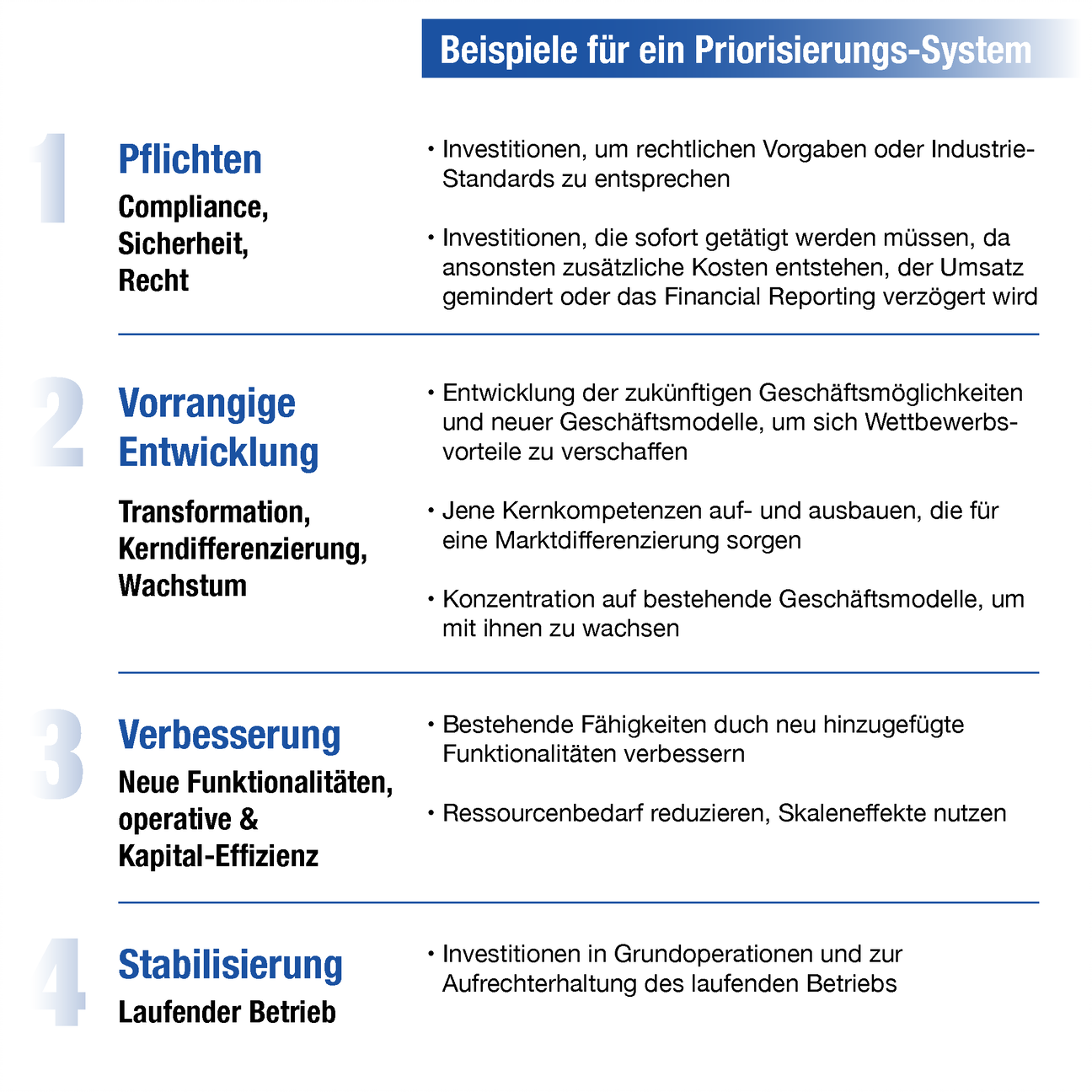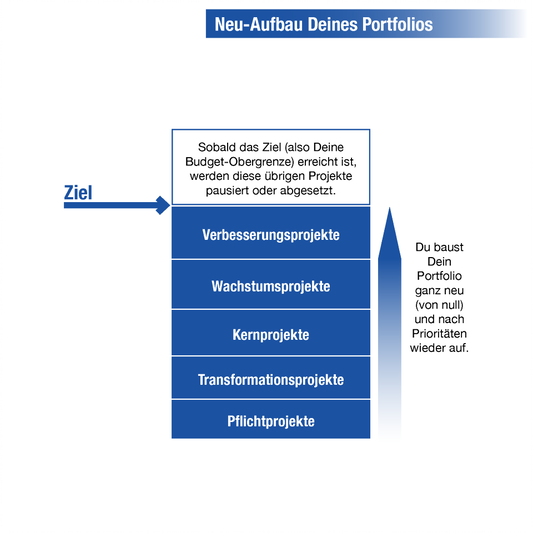6 min read
COVID-19: Make your project portfolio crisis-proof! We present the zero-based project prioritization as a solution
![]() Michael Fenske
:
06.11.2020
Michael Fenske
:
06.11.2020
"Making the best out of it": In Corona times, this is an empty phrase for many - but for responsible project portfolio managers it is the order of the day. We will show you why agile project portfolio management is particularly effective now.
In this blog post we list the challenges you face (not only) because of COVID-19 in the Project Management Office - and give recommendations on how to overcome them. So now and in the future you will be able to lead your portfolio management out of crises in a stronger position. The way to get there, as much as I can tell you, is via zero-based project prioritization. But first a short overview:
Inhalt
Herausforderungen
- Companies must reduce costs - but must not neglect new, innovative projects.
- Once a project is up and running, many companies do not have the tools to measure whether the direction is right.
- This problem of insufficient project analysis is compounded by the fact that in times of crisis important projects are actually given too few resources.
- If projects are not systematically evaluated and prioritized in the project portfolio management, manpower, time and resources flow into the wrong projects in the worst case.
Recommendations
Both managers with responsibilities in planning, budgeting and cost control and all PMO staff involved in portfolio management should focus on the following points in order to be able to react quickly to current and future challenges:
- Use a portfolio analysis evaluation system to prioritize projects based on strategic business objectives. For this purpose, a division into mandatory projects, transformation projects, core projects, growth and improvement projects is helpful.
- Pause work on current projects and new requests and set the portfolio (e.g. IT project portfolio) to zero
- End project portfolio management by discontinuing all projects that have not been prioritized accordingly.
- Establish zero-based project prioritization as a powerful portfolio management measure that can be taken whenever major changes or in-depth reassessments are pending. This can save those costs that no longer support the strategic direction of the company.
Excursus: a trip to the offices
It's a staircase joke in the budgeting and controlling departments: the story of the civil servants who order two more plates of pencils at the end of the year, only to have their budget allocated for the next year. In fact, this is an apt description of a budgeting problem that builds on the previous year. This is why zero-based budgeting was developed some time ago, in which departments must always justify their entire budget anew. This procedure is effective, but it is also very time-consuming - and has therefore not yet become established everywhere. As a result, many companies still receive mass orders at the end of the year. However, the principle of zero-based budgeting is an effective tool that can be transferred to project portfolio management. And in this article you will encounter zero-based project prioritization.
Introduction: Challenges in times of crisis
If you want to give the new coronavirus a good characteristic, then it is certainly this one: It forces us to be better positioned to deal with crises in the future. This applies in particular to Project Management Offices (PMO), for example in terms of IT project portfolio management or portfolio management in marketing. Because whenever difficult times make it necessary to cut costs, old portfolio management structures no longer work.
If there is only a limited budget available for your project portfolio, the consequence is that planned projects remain in the pipeline and therefore nothing new can be realized. This is because the majority of the tightened budget is usually tied up with projects that were started in the past. Whether these projects still make strategic sense and are therefore in the interest of the company due to the changed conditions is often not even questioned.
Disruptions such as the influences of COVID-19 are currently having an almost disruptive effect, so that many projects are becoming obsolete - in view of declining revenues, staff reductions, interrupted supply chains or even just because of a realignment of the business strategy. In times of crisis the motto is therefore "more agility in project management", and a realignment of the project portfolio is needed!
The tool of zero-based project prioritization is extremely helpful for this purpose. Similar to zero-based budgeting, it is a measure that requires a lot of attention, time and energy - but rewards your efforts with deep insights into the importance of your projects. This makes it the budget and project tool of your choice, especially in times of crisis. Zero-based project prioritization means: All your projects are first stopped and then objectively re-sorted in an evaluation grid. This creates a completely new, perhaps even surprisingly different, project portfolio that is crisis-proof, supports your company's long-term strategy and is subordinate to the circumstances of tight budgets. Ready for it? Here come our recommendations!
Recommendations for the realignment of your project portfolio
Create a prioritization system
Especially in times of crisis, but also as a matter of principle: Don't put your money into the wrong projects. But which project is the right one? Which new idea should be pushed, which project cross-country skier should finally be buried? In order to decide this, a rating system for your project portfolio, which could look like this, for example, helps:

Such an evaluation framework should be familiar to the management level as well as to project managers and other decision-makers, so that the evaluation of projects can be carried out according to uniform criteria throughout the company. If you want to achieve a successful rebuilding of the project portfolio according to the motto "From zero to hero", these five criteria for project evaluation will help you:
- Compulsory projects
These projects are not simply "important" or "urgent" - they must be carried out on a mandatory basis. So think carefully about which projects you want to give this label to. Compulsory projects are, for example, those that are related to legal requirements or concern compliance or the security of your company. - Transformation Projects
Your company wants to open up new business models or markets? Everything that has to do with future competitive advantages fulfills this criterion. - Core projects or core differentiation projects
Projects from this category help your company to position itself in the market and differentiate itself with a decisive competitive advantage. - Growth projects
Projects that focus on business development within the current business models are among the growth projects. - Improvement
This refers to projects that aim to create operational or capital-based value. Projects that deal with service/maintenance or fundamental improvements are also included.
Once this evaluation framework has been agreed upon in your company, project portfolio management "only" lacks an overall budget (target expenditure). Then the zero-based prioritization process can start and build your portfolio with realignment from zero - up to the limit set by the new budget.
Announce a (theoretical) stop of all projects
Stop all existing projects, activities and requirements in your portfolio for the next budget period. To make the prioritization process effective, keep two important points in mind:
- The process of setting the project portfolio to zero must be limited to future projects. Projects that are already in progress should not be affected. Only when the zero-based prioritization process is complete do decision makers decide which projects to stop, restart or continue.
- Zero-based prioritization brings a paradigm shift to your project portfolio management: You no longer have to justify why a project is stopped; instead, you can use zero-based prioritization to justify why a project should start at all.

Rebuild the portfolio - project by project
This work is at the heart of zero-based project prioritization: Now it is a matter of putting every single project for which the Project Management Office is responsible to the test and classifying it according to the evaluation system. Then the portfolio, for example in IT project management, is created from scratch until, sorted by priority, it reaches the budget target. The project portfolio management and the management level must work together on prioritization: If they agree on which projects can remain in the portfolio, they can then decide together which ones have to go. In order to make the rebuilding of the project portfolio meaningful, the following points should be considered:
- Start with the mandatory projects. Review your decision and ask the decision makers of each project to explain why it is a mandatory project for them.
- Then add the transformation projects. They are important for sustainable success.
- We continue with the core projects. Are they in line with the business strategy? "Nice to have" is not enough. Only core differentiation projects that are dedicated to strengthening competitive advantage are allowed in the portfolio.
- Then there are the growth projects. Growth is important, of course. But it should make sense! Only growth projects with measurable added value will be included in the newly established portfolio.
- ... and finally the improvement projects. These projects offer more efficiency and effectiveness. But to varying degrees. Fill your portfolio sorted by improvement potential.
Finalize the portfolio
Soon it is done: Now it is still a matter of closing the bag. In final discussions and reviews with the PMO and the management level, it will be finally determined which projects will remain in the portfolio under the new budget conditions. But keep projects that didn't make it into the final portfolio this time around: If your company has successfully emerged from the crisis, the budget will probably be increased again and the hour for postponed projects may have come.
Conclusion: everything new. Everything better.
That's what every project management office wants: a project portfolio, freshly set up, objectively tidied up and filled with the company's most promising projects. Congratulations on this new start! But we also know that a well-managed project portfolio requires constant attention. So if you have any questions or want to know how digitization can get your projects moving and what choosing the right PM software can contribute to a smoothly running portfolio management - just contact us. We look forward to hearing from you!
The content of this article is based on an article by Gartner. Here is the link to zero-based project prioritization on Gartner.com (engl., registered users)
Jetzt anmelden - Can Do Newsletter
Michael Fenske works as a freelance author for Can Do GmbH.
Why Do Projects Fail? 5 Common Reasons - And How to Avoid Them
Projects are often complex, and even with the best intentions and a competent team, success can elude us. But why do so...
Cost-Cutting - Increasing Efficiency Without Additional Resources
Cost-cutting is currently at the top of the agenda for many companies. In the face of economic uncertainty and rising...
.png?width=200&height=80&name=CanDo%20Logo%20transparent%20(500%20x%20200%20px).png)
